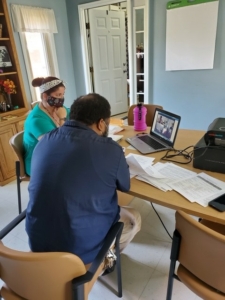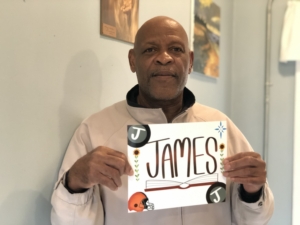Proving that Everybody is Somebody
Overcoming the Identification Crisis for People Experiencing Homelessness
To get housing, you need ID. To get an ID in Ohio, you need a proof of legal residence in the United States, proof of Ohio residency and proof of a social security number. Those are the minimum requirements. How do you provide any of these documents if you have been experiencing homelessness or living on the streets and in a shelter?

Director of the Identification Crisis Collaborative, Eileen Kelly
When a new resident arrives at Joseph’s Home, staff evaluate which forms of identification (ID, birth certificate, social security card) residents need so they can access opportunities for housing and jobs, and even express their right to vote. In previous years, Eileen Kelly, director of the Identification Crisis Collaborative, helped residents secure these important documents. Eileen recently trained Joseph’s Home staff members to complete this process in-house.
Since 1999, Eileen has been helping Cleveland’s poorest citizens face the systematic inequities caused by identification requirements. Eileen spent years working at St. Colman’s Church on Cleveland’s near West Side, providing meal assistance, access to emergency funds, computer labs and much more to anyone who sought help. In 1999, she noticed a growing number of people coming to her for help obtaining IDs and birth certificates that were required to cash checks, open bank accounts, obtain housing and apply for jobs.

Respite Care Manager Raven and Operations Manager Alphonso participate in an online training with the Identification Crisis Collaborative.
Soon, the word got out and she was overwhelmed with requests for help. The Identification Crisis Collaborative was born to help those in need identify the documents they needed, file the paperwork necessary, provide financial support to obtain these documents, and train other organizations and partners to provide these services, including Joseph’s Home.
For those experiencing homelessness, the barriers to obtaining identifications can be daunting. Lack of computer access, little money and having no experience with these systems can prevent someone from obtaining an ID independently. Eileen sees this work as addressing the first of many challenges people experiencing homelessness face. “My goal is to address that first challenge so they don’t get stuck. Once they have an ID, then they can move onto housing, jobs, health care, voting, whatever they need to do. It arms them with that basic need for the rest of their journey.”
“There are ways to prove people are somebody without IDs. One person at a time—one precious person at a time—we try to straighten up the mess so they can get their identification.”
— Eileen Kelly, Identification Crisis Collaborative
VOTE 2020: Ensuring Everyone’s Voice is Heard
People who are experiencing homelessness have a right to vote and to express their views by voting in all elections. Yet because of barriers to the registration process, and access to voting; coupled with the disproportionate amount of black and brown people who are also homeless, they are often disenfranchised and kept out of the voting process. — National Alliance to End Homelessness

“My family was adamant that voting is important. My mother used to tell me that I was blessed to be able to vote because she experienced a time when many Black people couldn’t.” said Joseph’s Home alumnus James. “Voting makes you an American and is a great privilege.”
The right to vote, however, has not always been fully extended to oppressed groups: Black people and people experiencing homelessness. Although the 15th Amendment gave Black men the right to vote in 1870, states and local municipalities continued to use tactics such as poll taxes, literacy tests and even intimidation to stop people from casting ballots.
In March 1965, Black activists and civil rights leaders, including the late Representative John Lewis, led the Selma-to-Montgomery March, which raised awareness of the barriers faced by Black voters and called for national voting equality. The Voting Rights Act of 1965 followed, which guaranteed the right to vote for Black Americans and worked to remove barriers, including requiring literacy tests, mandating federal oversight of voter registration, and giving the U.S. attorney general the duty of challenging the use of poll taxes for state and local elections. This year, we also celebrate the 100th Anniversary of the passing of the 19th Amendment which afforded women the right to vote.
But, barriers still remain. Voting requires a residence or particular forms of identification, which are often unavailable or difficult to access for the homeless population. Cuyahoga County requires being a resident of Ohio for at least 30 days to register to vote, which is verified by an address.
For many Joseph’s Home residents, getting an ID is a turning point. Opportunities for housing become more attainable and some barriers decrease. For James, it is not just about his opportunities, but also future generations. “You are voting for your right! But you are also voting so your children, grandchildren, great-grandchildren can come into a better world.”
“Voting and participating in the democratic process are key. The vote is the most powerful nonviolent change agent you have in a democratic society. You must use it because it is not guaranteed. You can lose it.” – Representative John Lewis
The voter registration deadline in Ohio is October 5. To register, visit www.olvr.ohiosos.gov


